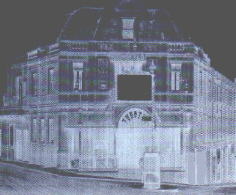
|

|
| Use the text links for more information! |
No sidebar menus?, Click Here and re-select |
| Theatre Royal The Theatre Royal opened on 13th October 1886 and was Exeter's fourth theatre. Less than a year after it opened it was burned out during a performance of Romany Rye. 188 people were burned to death, the building holds the record for the most deaths in a single building in the UK. After repairs, the building was re-opened and could hold 1500 people but all the seats were rarely filled and for this reason the theatre eventually failed. The Theatre Royal closed in 1962. For further information click here. |
 |
| Harry Hems
Just down Longbrook Street from here is Harry's Restaurant on the right hand side.
Don't bother taking a look just now but next time you're passing its worth a look. This was Harry
Hems Workshop built in 1881-82 and enlarged in 1884. He was a sculptor and originally came to Exeter in 1866 to work on
the Royal Albert Memorial Museum. He found a lucky horseshoe which is now fixed above the doorway of this
building.
The building itself is very impressive in a style known as 'domesticated' or modified
Queen Anne Flemish. The architect was R. Medley Fulford. The workshop made carved stonework
for churches and towhalls all over Britain including around 100 statues for the High Altar screen at
St Alban's Abbey and the huge William Of Orange
Statue in Belfast. |
He died in 1916. The place has been used as a restarant in the past and a church reading room.
The statue in the centre column of the building is "Art Personified", whatever that is or means.
There is also a plaque which says that the Long Brooke crossed this road seventy feet west (with an arrow pointing towards the City.'The wooden footbridge which spanned it was removed when the river was arched over in AD1832. William The Conqueror and his troops waded it's waters intent upon beseiging our City AD1069'. The plaque was erected by Harry Hems. Exit the Black Horse and turn left and left again. Eventually you'll come to New North Road with the Locomotive Inn on your right. Nip in here before heading off to the Thirsty Camel which is about 50 yards further back along the road on your right. |
|
|
The Oddfellows (formerly Malloys, Thirsty Camel, The Gate) opened in
2006. It is shown on an O.S. map of 1876 as the Odd Fellows Arms.
The Old Firehouse is over the road. Amazingly enough this place used to be the firehouse opening as a pub in 1986. The gate piers originally held lamps. Stairs and a trap door hoist led to two large workshops from which a further trap door led to the roof and a wooden platform used for drying hoses. When this place was a firehouse, there was a pub next door (the Black Horse Tap). The firehouse moved to Danes Castle in 1931. The original building was constructed in 1833, a two storey red brick engine house with a three storey Georgian style range behind. It housed the West of England Insurance Company Fire Brigade from 1834 to 1888, finally vacated by the fire services in 1931 when the Exeter Fire Brigade moved to their new premises. This fire station was eventually auctioned for £1500.00 and later partly demolished at a cost of £2000.00. |
|
|
Head back towards High St. At the top of Longbrook St, you may want to nip into The King Billy,
formerly Strikers Sports Bar (until 2005).
During the time of the Theatre Royal, this place was a haven for the actors and performers. It was then known as The Horse & Groom. Demolished in 1966 and rebuilt it was known briefly as The Dunkirk before becoming the Horse & Groom again. In the nineties it became Strikers Sports Bar. At the very top of High Street is the site of the old City East Gate which was removed in 1769, the Eastgate became the Salutation Inn after it ceased being a form of defence. Just behind a plaque to mark the position of the gate is an emergency exit for the underground passages. |
|